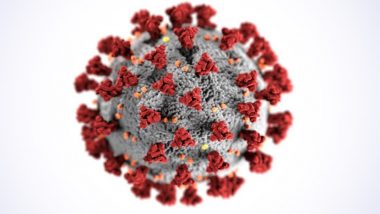New Delhi, December 25: A total of 63 cases of COVID-19 sub-variant JN.1 have been detected till Sunday, with Goa reporting the highest number of cases, Health Ministry sources said on Monday. They said of the total cases of the JN.1 variant, 34 are from Goa, nine from Maharashtra, eight from Karnataka, six from Kerala, four from Tamil Nadu and two from Telangana.
However, there has been no clustering of cases reported so far and all the cases of the JN.1 subvariant have mild symptoms, they added. Meanwhile, the total number of active cases of COVID-19 in the country stands at 4,054, with the highest number of cases coming from Kerala. COVID-19 Variant JN.1: 63 Cases of New Coronavirus Strain Reported Across India Till Yesterday: Report.
"Thirty-seven COVID-19 cases are from Goa, 344 from Karnataka, 3128 from Kerala, and 50 from Maharashtra," according to Health Ministry data. Former World Health Organisation (WHO) chief scientist Dr Soumya Swaminathan has said that there is no need to panic as JN.1 is a variant of interest and not of concern. She urged people to be cautious by taking proper precautionary measures.
"We need to be cautious, but we don't need to worry because we don't have any data to suggest that this variant JN.1 is more severe or it's going to cause more pneumonia, more deaths," Dr Swaminathan, a former Director General of the Indian Council of Medical Research (ICMR) had told ANI. COVID-19 Variant JN.1: WHO Classifies New Coronavirus Strain As 'Variant of Interest'; Here's Why.
India SARS-CoV-2 Genomics Consortium (INSACOG) chief Dr NK Arora said that no additional dose of vaccine is needed against the subvariant at present. "I would say prevention is required for all those who are 60 years of age or older, who are likely to have comorbidities and those who are on drugs that suppress our immunity, like cancer patients. If they have not taken precaution so far, then they are advised to take precaution; otherwise, there is no need for any additional doses," he told ANI.
The INSACOG chief asserted that various subvariants of Omicron have been reported but none of them have increased severity. "Every week you hear something new coming up in different parts and then it spreads all over India. We have identified a large number of subvariants, over 400 subvariants, or mutations of this virus, and fortunately, none of these Omicron variants have really been associated with more severe disease or hospitalisation," he said. He explained the major symptoms of JN.1, highlighting that they are similar to those of other subvariants.
"Symptoms are very similar on the basis that one cannot differentiate JN.1 from other subvariants of Omicron like fever, nasal discharge and cough. There can be occasional diarrhoea and severe body aches, and usually they recover in two to five days," the doctor outlined.
The World Health Organization (WHO) recently classified JN.1 as a variant of interest, distinct from its parent lineage BA.2.86. However, the global health body emphasised that the overall risk posed by JN.1 remains low based on current evidence.
(The above story is verified and authored by ANI staff, ANI is South Asia's leading multimedia news agency with over 100 bureaus in India, South Asia and across the globe. ANI brings the latest news on Politics and Current Affairs in India & around the World, Sports, Health, Fitness, Entertainment, & News. The views appearing in the above post do not reflect the opinions of LatestLY)













 Quickly
Quickly


